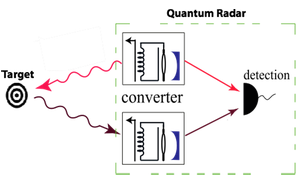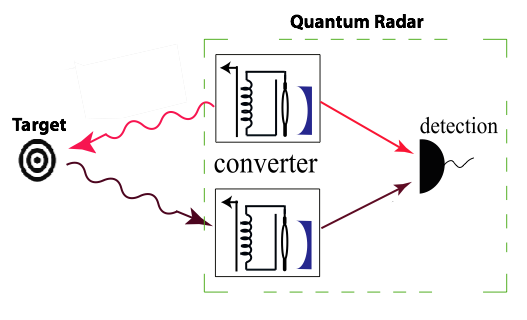Quantum Mechanics Could Improve Radar
Quantum-mechanical effects can be exploited to enhance the sensitivity of microwave technologies such as radar, according to new calculations. The authors describe a scheme that would extend the notion of “quantum illumination”—which aids the sensing of weakly reflective targets in a noisy background—from visible wavelengths to microwaves, where its benefits should be more significant. If extended further to radio frequencies, the method could increase the sensitivity of magnetic-resonance imaging.
Quantum illumination was first outlined seven years ago by Seth Lloyd and co-workers of the Massachusetts Institute of Technology [1,2]. A light beam is split into two beams that are quantum-mechanically entangled, meaning that the quantum states of the photons in each beam are strongly correlated. When two correlated beams interfere in a detector, the signal is amplified compared with uncorrelated beams. In quantum illumination, one of the two beams (the idler) goes straight to a detector, but the other (the probe) is sent out to sense a target. If the target is present, an echo is reflected from it and travels back to the detector, where it interferes with the idler beam. Even if the entanglement between the two beams is broken up by noise in the environment, some residual correlations remain that affect the interference, so that probe photons can be distinguished from background photons. This makes it possible to identify reflections from the target even when this echo is very weak.
Quantum illumination was demonstrated experimentally in 2013 for visible wavelengths [3], but Stefano Pirandola of the University of York in the UK and coworkers say that at longer wavelengths quantum illumination is both harder to achieve and potentially more useful. They describe a scheme for conducting the experiment at microwave (radar) frequencies and predict its effectiveness with currently available technology.
For “stealth” objects like aircraft and boats developed by the military, radar reflections are reduced by special surface coatings and may be swamped by the ambient thermal background. But if the probe signal contained photons “labeled” by quantum illumination, a faint radar echo would still stand out.
At the core of the proposed method is a means of interconverting microwave and optical signals using a so-called electro-optomechanical converter [4,5]. This device would consist of optical and microwave cavities for storing each kind of radiation, with a nanoscale vibrating object (such as a piezoelectric crystal or a metallic membrane) serving as the connection between the two. The oscillator can couple electromagnetic vibrations in the two cavities, despite their different frequencies.
In the first step of their proposed experiment, a converter entangles the radiation in the two cavities, and the microwaves are then released as the probe beam, while the visible photons become the idler beam. If the probe bounces off the target and returns to the device, a second electro-optomechanical converter converts it to a visible-light beam, which is then allowed to interfere with the idler in a detector. The researchers call their scheme “quantum radar.”
“Our work supports the use of quantum correlations as a general resource for quantum sensing in a very noisy background, like that in the microwave regime,” says Pirandola. In principle the method could work with such weak sensor beams that it would be totally “noninvasive”—for example, a military aircraft wouldn’t register that it had been probed.
Applied physicist Michael Devoret of Yale University calls the work “very interesting and valuable,” adding that “the basic ideas behind this kind of scheme are exciting intellectually.” But whether the proposed method will work remains to be seen. ”I’m not sure it could be applied to real radar, because the photon absorption in air might scramble everything,” says Devoret. Constructing a working device “is challenging and will require some time,” Pirandola acknowledges.
But the researchers say that it might also be possible to extend the idea to radio frequencies. That would open up new opportunities for non-invasive detection, for example using magnetic-resonance methods such as NMR and MRI for looking at delicate biological samples where absorption of radiation must be minimized.
This research is published in Physical Review Letters.
–Philip Ball
Philip Ball is a freelance science writer in London. His latest book is How Life Works (Picador, 2024).
References
- S. Lloyd, “Enhanced Sensitivity of Photodetection via Quantum Illumination,” Science 321, 1463 (2008)
- S.-H. Tan, B. I. Erkmen, V. Giovannetti, S. Guha, S. Lloyd, L. Maccone, S. Pirandola, and J. H. Shapiro, “Quantum Illumination with Gaussian States,” Phys. Rev. Lett. 101, 253601 (2008)
- Z. Zhang, M. Tengner, T. Zhong, F. N. C. Wong, and J. H. Shapiro, “Entanglement’s Benefit Survives an Entanglement-Breaking Channel,” Phys. Rev. Lett. 111, 010501 (2013); E. D. Lopaeva, I. Ruo Berchera, I. P. Degiovanni, S. Olivares, G. Brida, and M. Genovese, “Experimental Realization of Quantum Illumination,” 110, 153603 (2013)
- J. Bochmann, A. Vainsencher, D. D. Awschalom, and A. N. Cleland, “Nanomechanical Coupling between Microwave and Optical Photons,” Nature Phys. 9, 712 (2013)
- R. W. Andrews, R. W. Peterson, T. P. Purdy, K. Cicak, R. W. Simmonds, C. A. Regal, and K. W. Lehnert, “Bidirectional and Efficient Conversion between Microwave and Optical Light,” Nature Phys. 10, 321 (2014)





